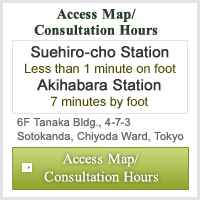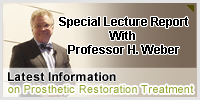トップへ » Considering Dentures? » Case Introductions
An Introduction of Cases Treated With the Telescope System
Here we will introduce a few cases that were treated using the telescope system.
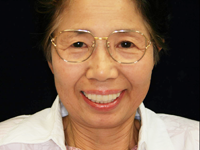 One of our patients had her upper jaw treated using Riegel telescope and her lower jaw treated using Konus telescope. She told us that the first one to notice her transformation was her grandchild.
One of our patients had her upper jaw treated using Riegel telescope and her lower jaw treated using Konus telescope. She told us that the first one to notice her transformation was her grandchild.
She says her grandchild said over and over again, "Grandma, your teeth are so beautiful!"
Before she came to Inaba Dental Office, she had been receiving treatment over the last 3 years from a clinic introduced to her that was a 30 minute walk from where she lived. She said that even after treatment, she still could not bite. She was very eager to be treated at our clinic and she told us after treatment that the results were even better than she had hoped for.
She shared with us the following:
"My case was very serious and I used to say, 'No matter how much I try to explain the pain of eating, no one understands.' I never would have thought using my front teeth would be so easy after putting in my Riegel telescope dentures. I can even eat corn on the cob and pickled vegetables!"
Nothing encourages us more in our clinical operations than hearing the joyful voices of our satisfied patients.
An advanced [Telescope] case treated with Riegel telescope restores a patient's ability to bite
[Riegel telescope case]
A patient came to us wearing dentures with magnetic clasps saying, "I can't bite into things..." The strength of the magnetic clasps was such that the dentures could be removed by hand. It is no wonder that they came loose easily when chewing food.
Riegel telescope dentures use a small locking mechanism placed on their inner side. The dentures can be put on and taken off by opening and closing this lock. There is never any risk of them slipping off while eating.
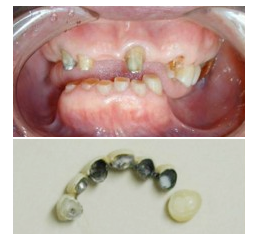 This case was extremely complicated. The patient only had front teeth left on the upper jaw and was using a simple set of dentures. The problem was the bottom teeth. The bottom front teeth were greatly worn down and as for the back teeth, the bones had completely absorbed the dentures.
This case was extremely complicated. The patient only had front teeth left on the upper jaw and was using a simple set of dentures. The problem was the bottom teeth. The bottom front teeth were greatly worn down and as for the back teeth, the bones had completely absorbed the dentures.
The patient came to our clinic extremely troubled because they were not able to eat and their dentures easily broke.

First, we reinforced and repaired the patient's usable teeth. Since the patient's bite alignment plane was also off, we aligned it to achieve bilateral symmetry. This is where we put false teeth into the upper jaw. At this point, the patient was overjoyed to regain the ability to bite.
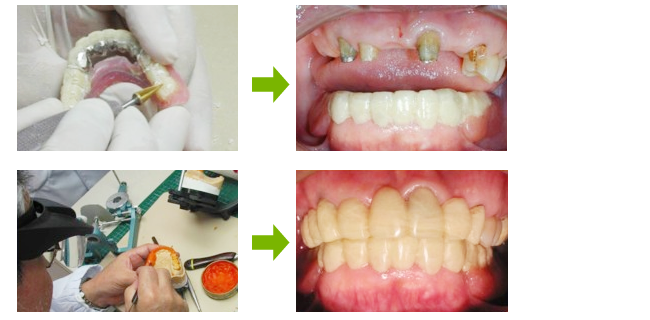
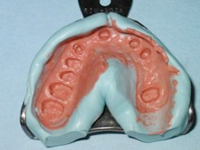 After making a wax mold and examining it, we decided to use Riegel telescope to fix the condition of the upper and lower teeth. The pictures below are of precision molds we had taken.
After making a wax mold and examining it, we decided to use Riegel telescope to fix the condition of the upper and lower teeth. The pictures below are of precision molds we had taken.

The finished upper and lower Riegel telescope dentures.


The picture on the left shows the lock (Riegel lever) in the closed position while the picture on the right shows it in the opened position.
The lock can be easily opened and closed using a finger, and when it is closed it is unnoticeable to the tongue. It helps to think of it as a kind of removable bridge.
Since the prosthetic teeth are ceramic, the final product is esthetically beautiful. The metallic parts are completely hidden when the dentures are set in place inside the mouth.
*Cases introduced on the website are completely unique to the patients and actual treatment periods and methods vary for each patient.
A case concerning severe gingivitis and dentures
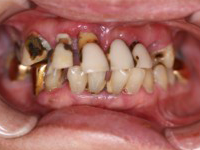 This patient came to our clinic suffering from gingivitis and bad breath. The patient shared that they were aware of how bad their situation was and decided to visit us to take care of the problem once and for all.
This patient came to our clinic suffering from gingivitis and bad breath. The patient shared that they were aware of how bad their situation was and decided to visit us to take care of the problem once and for all.

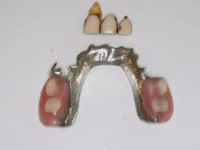 Unfortunately, the patient's front teeth were loose and there was nothing we could do to preserve them. In this case we had to extract the loose teeth.
Unfortunately, the patient's front teeth were loose and there was nothing we could do to preserve them. In this case we had to extract the loose teeth.

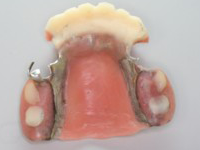 Before we extracted the patient's teeth, we altered the dentures so that they wouldn't have to go around with no front teeth after the extraction. We made false teeth for the front ones and reinforced the upper jaw so that the patient could bite again.
Before we extracted the patient's teeth, we altered the dentures so that they wouldn't have to go around with no front teeth after the extraction. We made false teeth for the front ones and reinforced the upper jaw so that the patient could bite again.
Normally when teeth are extracted it is necessary to leave the area open for a while which can hinder the patient's lifestyle. In order to spare the patient from this negative experience, we establish a treatment plan in advance.

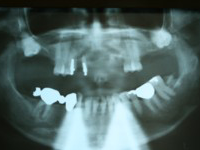 We extracted 2 teeth from the upper jaw and used 4 others to support Resilience telescope dentures. There were more teeth left in the lower jaw but since many of them were loose due to pyorrhea, we chose the Riegel telescope method which would secure and link them together.
We extracted 2 teeth from the upper jaw and used 4 others to support Resilience telescope dentures. There were more teeth left in the lower jaw but since many of them were loose due to pyorrhea, we chose the Riegel telescope method which would secure and link them together.

We attached inner crowns to the upper jaw and used them to snap the Resilience telescope dentures into place.


We secured the loose teeth of the lower jaw by linking them with an inner crown, which was further secured with the Riegel telescope dentures that fit over them.


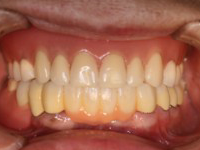 This is when we set the dentures in place in the patient's mouth. Only white is visible making these dentures undetectable to other people.
This is when we set the dentures in place in the patient's mouth. Only white is visible making these dentures undetectable to other people.

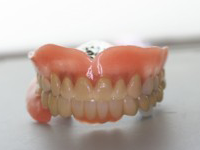
The patient was very pleased after putting the dentures on and shared with us that they wanted to hurry up and go out to talk and smile with new people. This was significant as the patient had had a complex about talking and smiling before they came in.
We are always very pleased to see this patient's beautiful smile each time they come in for maintenance.
*Cases introduced on the website are completely unique to the patients and actual treatment periods and methods vary for each patient.
[Full dentures] are loose and the patient can't bite. They experience pain when moving their mouth
[First visit]
The patient came to our clinic stating the following reasons:
+ "My dentures are so loose that I cannot bite. It hurts every time they move..."
+ "It is a bother to talk in front of people".
The patient told us that they had an inferiority complex about their teeth.
![[Full dentures]](/images/case015.png)
They wanted us to help alleviate the pain so they could enjoy eating and get over their inferiority complex. We decided to treat with full dentures made using the maxillomandibular simultaneous impression method to address the patient's pressing concerns.
[Taking the first mold impression]
Comparing the dentures that the patient came in with to their teeth mold, we found out that the dentures where smaller than the space in the patient's mouth and were nearly completely lacking support from the mouth muscles.
![[Full dentures]](/images/case016.png)
![[Full dentures]](/images/case017.png)
We made a tool based on this model to create a precise mold.

[Second visit to the clinic]
![[Full dentures]](/images/case018.png) The picture below is of the Gothic arch. It is used to record the movements of the jaw. In this case the jaw movements were normal.
The picture below is of the Gothic arch. It is used to record the movements of the jaw. In this case the jaw movements were normal.

Using the upper tray, we take a precise mold of the upper and lower jaw. At this time we are simultaneously recording the position of the jaw in regards to the central point of the body, and measuring the height of the bite alignment.
As the mold is being taken, we have the patient swallow their saliva in order to recreate the state of the mouth muscles while eating.
![[Full dentures]](/images/case019.png)
![[Full dentures]](/images/case020.png) After taking the mold, we choose artificial teeth that match the patient's skin color and facial features.
After taking the mold, we choose artificial teeth that match the patient's skin color and facial features.

![[Full dentures]](/images/case021.png) We transfer the myriad data to a bite alignment device called an actuator. Then we make the dentures using this model.
We transfer the myriad data to a bite alignment device called an actuator. Then we make the dentures using this model.

We create a shape using wax before the dentures are complete, line up the artificial teeth and then check everything. This is when we make detailed checks for things like pronunciation, comfort, and esthetic beauty.
![[Full dentures]](/images/case022.png)

![[Full dentures]](/images/case023.png) We conduct polymerization using the Ivocup-System. This transforms the wax into a hard material.
We conduct polymerization using the Ivocup-System. This transforms the wax into a hard material.

This is when the completed dentures were first placed into the patient's mouth. We insert a bite alignment lead called a 'full-balanced occlusion'. The information put into the actuator matched up perfectly with the conditions inside of the patient's mouth.
![[Full dentures]](/images/case024.png)
We made a few final adjustments after putting the dentures in and the patient is now able to enjoy them as if they were a part of his own body. The patient was also very pleased that pronunciation improved dramatically thanks to the dentures.
*Cases introduced on the website are completely unique to the patients and actual treatment periods and methods vary for each patient.
カテゴリー一覧
- Considering Dentures?
- Full Dentures, a Strong Bite, and a Beautiful Smile
- Unnoticeable Partial Dentures
- Dentures in Your 30s
- Resilience Telescope
- Konus Krone
- Lab Intec, Onsite Dental Technician Office
- What is the Telescopic System?
- Process of Getting Dentures
- Worrying about Implants
- Different from Insurance Covered Dentures
- Denture Maintenance
- Dentures and TMJ Arthrosis
- Questions about Dentures
- Inquiries from Overseas
- Case Introductions
- Hear from Our Patients
- Costs
- Concerning Medical Expense Deductions
- Our Clinic
We hold free consultations for dentures.
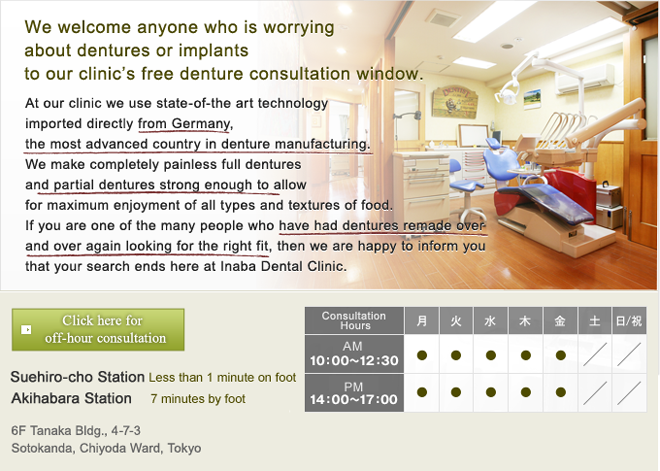
トップへ » Considering Dentures? » Case Introductions


